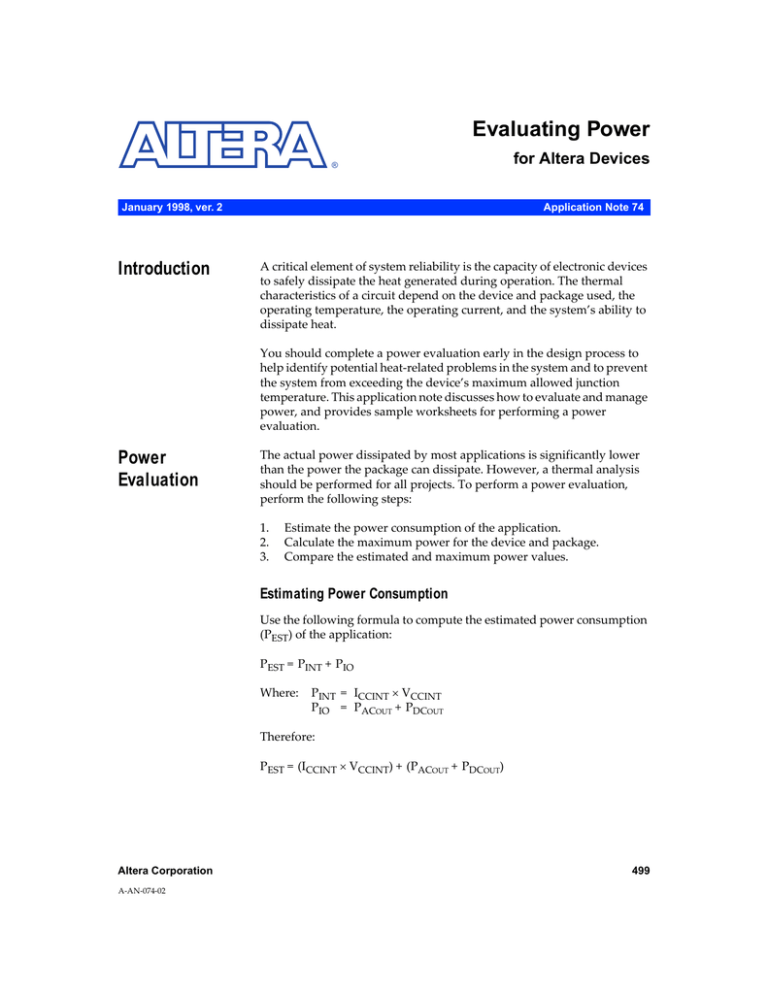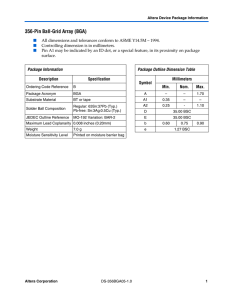
Evaluating Power
®
January 1998, ver. 2
Introduction
for Altera Devices
Application Note 74
A critical element of system reliability is the capacity of electronic devices
to safely dissipate the heat generated during operation. The thermal
characteristics of a circuit depend on the device and package used, the
operating temperature, the operating current, and the system’s ability to
dissipate heat.
You should complete a power evaluation early in the design process to
help identify potential heat-related problems in the system and to prevent
the system from exceeding the device’s maximum allowed junction
temperature. This application note discusses how to evaluate and manage
power, and provides sample worksheets for performing a power
evaluation.
Power
Evaluation
The actual power dissipated by most applications is significantly lower
than the power the package can dissipate. However, a thermal analysis
should be performed for all projects. To perform a power evaluation,
perform the following steps:
1.
2.
3.
Estimate the power consumption of the application.
Calculate the maximum power for the device and package.
Compare the estimated and maximum power values.
Estimating Power Consumption
Use the following formula to compute the estimated power consumption
(PEST) of the application:
PEST = PINT + PIO
Where:
PINT = ICCINT × VCCINT
PIO = PACOUT + PDCOUT
Therefore:
PEST = (ICCINT × VCCINT) + (PACOUT + PDCOUT)
Altera Corporation
A-AN-074-02
499
AN 74: Evaluating Power for Altera Devices
The no-load power (PINT) value can be obtained from the “Power
Consumption” section in each device family data sheet. Because this value
is “unloaded,” it is necessary to add the power dissipated by the I/O
buffers—PDCOUT from steady-state outputs and the PACOUT current from
frequently switching outputs. PDCOUT depends on the number of steadystate outputs, the logic levels they drive, and the resistive load on each
output, as shown in the following formula:
d
PDCOUT =
∑ PDCn
n=1
Where:
d
PDCn
Vn
fn
=
=
=
=
Number of DC outputs
DC output power of output n
Voltage swing of output n
Switching frequency of output n
Table 1 shows the DC power dissipated by the output drivers of a device
with VCCIO set at 5 V under typical types of loads. The DC power
dissipated by the output driver does not equal the VCC × ICCIO value
because most of the DC power is consumed by the load. If you are using
a 3.3-V device or a non-5.0-V VCCIO, you can compute the power based on
the device’s IOH and IOL figures shown in the device family data sheet.
Table 1. DC Power Dissipated
Load Driven
PDCn (mW)
1-K pull-up resistor for low outputs
0.49
1-K pull-down resistor for high outputs
5.04
Bipolar for low outputs
0.16
Bipolar for high outputs
0.0576
CMOS inputs
Negligible
PACOUT depends on the capacitive load on each output and the frequency
at which each output switches, as shown in the following formula:
a
PACOUT =
∑ Cn Vn fn × VCCIO
n=1
Where:
500
a
Cn
Vn
fn
=
=
=
=
Number of AC outputs
Capacitive load on output n
Voltage swing of output n
Switching frequency of output n
Altera Corporation
AN 74: Evaluating Power for Altera Devices
The following equation shows the frequency of each output (fn), in terms
of the maximum clock frequency (fMAX) of the design and the average
ratio of I/O pins (togIO) toggling at each clock:
fn = (0.5) × fMAX × togIO
Inserting the equation for fn into the PACOUT equation and resolving the
summation for an average capacitive load yields the following formula:
PACOUT = (0.5) × OUT × CAVE × VO × fMAX × togIO × VCCIO
Where:
OUT = Total number of output and bidirectional pins
Table 2 shows the VCCIO and VO values for Altera devices.
Table 2. VCCIO & VO Values
VCCIO (V)
VO (V)
5.0
3.8
3.3
3.3
2.5
2.5
For example, the following equation provides the capacitive load for
applications with VCCIO = 5 V:
PACOUT = (0.5) × OUT × CAVE × 3.8 V × fMAX × togIO × 5.0 V
Calculating Maximum Power for the Device & Package
The following formulas are used to calculate the maximum allowed
power (P MAX) for a device:
T J – TA
P MAX = ------------------θ JA
Altera Corporation
or
T J – TC
P MAX = -----------------θ JC
501
AN 74: Evaluating Power for Altera Devices
The maximum allowed power is dependent on the maximum allowed
junction temperature (TJ) of the silicon, the ambient temperature of
operation (TA), and the package’s thermal resistance (θJA) when
configured in the system. The maximum junction temperature is specified
in the Altera® device family data sheets. The ambient temperature
depends on the application. The worst-case P MAX value is estimated
using the formula with θ JA, the junction-to-ambient thermal resistance.
The θ JA value for Altera devices is provided for still air (with convection
cooling only), and for a forced-air flow of 100 feet/second,
200 feet/second, and 400 feet/second. If heat-sinking is used to dissipate
heat and θ JA for a heat sink is given, you should use the case temperature
(TC) and the junction-to-case thermal resistance (θ JC) to calculate P MAX
for a device. θ JC is a measure of the lowest possible thermal resistance.
f
For thermal resistance values (θ JC and θ JA) of Altera devices, refer to the
Altera Device Packaging Information Data Sheet in this data book.
Comparing Maximum Allowed Power & Estimated Power
To avoid reliability problems, you should compare the values calculated
for the maximum allowed power and estimated power. The estimated
power should be the smaller of the two values. If the estimated power
exceeds the maximum allowed power, refer to “Thermal Management”
on page 509 for suggestions on how to reduce power requirements for a
design. Figure 1 shows a sample worksheet for evaluating power.
502
Altera Corporation
AN 74: Evaluating Power for Altera Devices
Figure 1. Power Evaluation Worksheet (Part 1 of 2)
Design___________________________
Device_________________________
Estimating the Power Consumption of the Application
Internal Power Calculation for All Altera Devices
FLEX 10K, FLEX 8000 & FLEX 6000 Devices
Standby current (ICC0)
Coefficient for ICC calculation. See the appropriate device family data sheet
for this value.
Maximum clock frequency (fMAX)
Total number of logic elements (LEs) used in the device (N)
ICC0 =
K=
fMAX =
N=
mA
µA/(MHz × LE)
MHz
LE
Average ratio of logic cells toggling (togLC) at each clock (typically 0.125)
togLC =
Total internal current (ICCINT)
ICCINT =
mA
PINT =
mW
ICCINT = ICC0 + K × fMAX × N × togLC
Total internal power (PINT)
PINT = VCC × ICCINT
MAX 9000 & MAX 7000 Devices
Coefficients for ICC calculation. See the appropriate device family data sheet
for these values.
A=
mA/LE
B=
mA/LE
C=
mA/(MHz × LE)
Number of macrocells with the Turbo Bit on (MCTON)
MCTON =
LE
Number of macrocells in the device (MCDEV)
MCDEV =
LE
MCUSED =
LE
Number of macrocells in the design (MCUSED)
Maximum clock frequency (fMAX)
fMAX =
MHz
Average ratio of logic cells toggling (togLC) at each clock (typically 0.125)
togLC =
Total internal current (ICCINT)
ICCINT =
mA
PINT =
mW
PDCOUT =
mW
ICCINT =
(A × MCTON) + [B × (MCDEV – MCTON)] + (C × MCUSED × fMAX × togLC)
Total internal power (PINT)
PINT = VCC × ICCINT
External Power Calculation for All Altera Devices
Power consumed by the DC output load (PDCOUT)
PDCOUT = PDCn
Average capacitive load (CAVE) at output pins
CAVE =
Number of output/bidirectional pins in the design (OUT)
OUT =
Average ratio of I/O pins toggling (togIO) at each clock (typically 0.125)
Power consumed by AC output load (PACOUT)
pF
togIO =
PACOUT =
mW
PIO =
mW
PACOUT = 1/2 × OUT × CAVE × VO × fMAX × togIO × VCCIO × 0.001
Total external power (PIO)
PIO = PDCOUT + PACOUT
Altera Corporation
503
AN 74: Evaluating Power for Altera Devices
Figure 1. Power Evaluation Worksheet (Part 2 of 2)
Total Power Calculation for All Altera Devices
Estimated total power (PEST)
PEST =
mW
PEST = PINT + PIO
Calculating Maximum Allowed Power for the Device & Package
θJA =
Thermal resistance of the device
Maximum junction temperature (TJ) as specified in the appropriate device
family data sheet.
˚ C/W
˚C
TJ =
Ambient temperature (TA) of the design
˚C
TA =
Maximum power (PMAX) allowed for the device
PMAX =
W
PMAX = (TJ – TA)/θJA
Comparing Maximum Power Allowed & Estimated Power
Is PEST < PMAX?
Yes or No
Tables 3 and 4 show design parameters for the sample power evaluations
shown in Figures 2 and 3. The design parameters are unique to the sample
designs and are not found in device family data sheets.
Table 3. Parameters for the Sample FLEX 10K Design
Parameter
OUT
Description
Number of outputs
Value
150
Number of 1-KΩ pull-up resistors Type of load
50
CMOS inputs
Type of load
100
CAVE
Average capacitance
35 pF
N
Number of logic elements used
2,747 LE
fMAX
Maximum operating frequency
20 MHz
PDCOUT
Static power consumed by
outputs
(0.49 mW × 50) + (0 mW × 231) = 24.5 mW
504
Altera Corporation
AN 74: Evaluating Power for Altera Devices
Table 4. Parameters for the Sample MAX 9000 Design
Parameter
Value
MCTON
139
MCDEV
560
MCUSED
500
MCTOFF
421
fMAX
40 MHz
OUT
211
Number of 1-KΩ pull-down resistors 10
CMOS inputs
201
CAVE
35 pF
PDCOUT
(5.04 mW × 10) + (0 mW × 201) = 50 mW
Figures 2 and 3 provide power evaluations for sample designs
implemented in FLEX® 10K and MAX® 9000 devices, respectively.
Altera Corporation
505
AN 74: Evaluating Power for Altera Devices
Figure 2. Sample Power Evaluation for a FLEX 10K Device (Part 1 of 2)
dsp_fir.tdf
Design___________________________
EPF10K50VBC356-2
Device_________________________
Estimating the Power Consumption of the Application
Internal Power Calculation
FLEX 10K, FLEX 8000 & FLEX 6000 Devices
Standby current (ICCSTANDBY)
Coefficient for ICC calculation. See the appropriate device family data sheet
for this value.
Maximum clock frequency (fMAX)
Total number of logic elements used in the device (N)
ICCSTANDBY =
0.500
mA
K=
45
µA/(MHz × LE)
fMAX =
50
MHz
N=
2,747
Average ratio of logic cells toggling (togLC) at each clock (typically 0.125)
togLC =
0.125
LE
Total internal current (ICCINT)
ICCINT =
773.09
mA
PINT =
2,551.2
mW
PDCOUT =
35
mW
CAVE =
35
pF
ICCINT = ICCSTANDBY + K × fMAX × N × togLC
Total internal power (PINT)
PINT = VCC × ICCINT
External Power Calculation for All Altera Devices
Power consumed by the DC output load (PDCOUT)
PDCOUT = PDCn
Average capacitive load (CAVE) at output pins
Number of output/bidirectional pins in the design (OUT)
OUT =
150
Average ratio of I/O pins toggling (togIO) at each clock (typically 0.125)
togIO =
0.125
PACOUT =
178.66
mW
PIO =
213.66
mW
PEST =
2,764.9
mW
Power consumed by AC output load (PACOUT)
PACOUT = 1/2 × OUT × CAVE × 3.3 V × fMAX × togIO × 3.3 V × 0.001
Total external power (PIO)
PIO = PDCOUT + PACOUT
Total Power Calculation for All Altera Devices
Estimated total power (PEST)
PEST = PINT + PIO
506
Altera Corporation
AN 74: Evaluating Power for Altera Devices
Figure 2. Sample Power Evaluation for a FLEX 10K Device (Part 2 of 2)
Calculating Maximum Allowed Power for the Device & Package
θJA =
8
Maximum junction temperature (TJ) as specified in the appropriate device
family data sheet.
TJ =
85
˚ C/W
˚C
Ambient temperature (TA) of the design
TA =
40
˚C
5.625
W
Thermal resistance of the device
Maximum power (PMAX) allowed for the device
PMAX =
PMAX = (TJ – TA)/θJA
Comparing Maximum Power Allowed & Estimated Power
Is PEST < PMAX?
Altera Corporation
Yes or No
507
AN 74: Evaluating Power for Altera Devices
Figure 3. Sample Power Evaluation for a MAX 9000 Device (Part 1 of 2)
atm_pkt.tdf
Design___________________________
EPM9560ARC304-15
Device_________________________
Estimating the Power Consumption of the Application
Internal Power Calculation
MAX 9000 & MAX 7000 Devices
Coefficients for ICC calculation. See the appropriate device family data sheet
for these values.
A=
0.68
mA/LE
B=
0.26
mA/LE
C=
0.052
mA/(MHz × LE)
Number of macrocells with the Turbo Bit on (MCTON)
MCTON =
139
LE
Number of macrocells in the device (MCDEV)
MCDEV =
560
LE
MCUSED =
500
LE
fMAX =
40
MHz
Average ratio of logic cells toggling (togLC) at each clock (typically 0.125)
togLC =
0.125
Total internal current (ICCINT)
ICCINT =
333.98
mA
PINT =
1,669.9
mW
PDCOUT =
50
mW
CAVE =
35
pF
Number of macrocells in the design (MCUSED)
Maximum clock frequency (fMAX)
ICCINT = (A × MCTON) + [B × (MCDEV – MCTON)] + (C × MCUSED × fMAX ×
togLC)
Total internal power (PINT)
PINT = VCC × ICCINT
External Power Calculation for All Altera Devices
Power consumed by the DC output load (PDCOUT)
PDCOUT = PDCn
Average capacitive load (CAVE) at output pins
Number of output/bidirectional pins in the design (OUT)
OUT =
211
Average ratio of I/O pins toggling (togIO) at each clock (typically 0.125)
togIO =
0.125
PACOUT =
350.79
mW
PIO =
400.79
mW
2,070.69
mW
Power consumed by AC output load (PACOUT)
PACOUT = 1/2 × OUT × CAVE × 3.8 V × fMAX × togIO × 5 V × 0.001
Total external power (PIO)
PIO = PDCOUT + PACOUT
Total Power Calculation for All Altera Devices
Estimated total power (PEST)
PEST =
PEST = PINT + PIO
Calculating Maximum Allowed Power for the Device & Package
Thermal resistance of the device
Maximum junction temperature (TJ) as specified in the appropriate device
family data sheet.
Ambient temperature (TA) of the design
Maximum power (PMAX) allowed for the device
θJA =
8
TJ =
90
˚ C/W
˚C
TA =
70
˚C
PMAX =
2.5’
W
PMAX = (TJ – TA)/θJA
508
Altera Corporation
AN 74: Evaluating Power for Altera Devices
Figure 3. Sample Power Evaluation for a MAX 9000 Device (Part 2 of 2)
Comparing Maximum Power Allowed & Estimated Power
Is PEST < PMAX?
Thermal
Management
Altera Corporation
Yes or No
The following guidelines reduce power dissipation and heat build-up for
an application:
■
Use available low-power features of the device. By turning the Turbo Bit
off, Classic devices and individual macrocells in MAX 9000, and
MAX 7000 devices can be configured for low-power operation, with
only a nominal increase in propagation delays. All macrocells in
MAX 9000 or MAX 7000 devices that do not need to run in highperformance mode should be set to low-power mode.
■
Choose a different device package. A ceramic or higher-pin-count
package can be used. Ceramic packages dissipate more heat than
plastic packages. Also, packages with higher pin counts can dissipate
more heat through the connections to the printed circuit board (PCB).
Finally, SuperBGA and power quad flat pack (RQFP) packages also
dissipate heat.
■
Use forced-air cooling and/or heat-sinking. Forced-air cooling improves
the efficiency of convection cooling, which reduces the surface
temperature of the device. A heat sink connected to a device
significantly increases heat dissipation by radiating heat via the metal
mass.
■
Slow the operation in portions of the circuit. I CC is proportional to the
frequency of operation. Slowing parts of a circuit lowers the I CC and
hence reduces the power. Altera devices provide global or array clock
sources for all registers. Signals that do not require high-speed
operation can use a slower array clock that significantly reduces the
system power consumption.
■
Reduce the number of outputs. DC and AC current is required to
support all I/O pins on the device. Reducing the number of I/O pins
may reduce the current necessary for the device, and thereby reduce
the power.
509
AN 74: Evaluating Power for Altera Devices
510
■
Reduce the amount of circuitry in the device. Power depends on the
amount of internal logic that switches at any given time. Reducing
the amount of logic in a device reduces the current in the device. The
same effect may be achieved by using a larger device, which also
provides increased heat dissipation and maintains a single-device
solution.
■
Choose a different device family. Some device families consume less
power than others. For example, the MAX 7000 family provides more
power-saving features than the MAX 5000 family. The Classic family
provides power-saving features for low-density designs, and
low-speed designs consume less power when implemented in FLEX
devices.
■
Modify the design to reduce power. Identify areas in the design that can
be revised to reduce the power requirements. Common solutions
include reducing the number of switching nodes and/or required
logic, and removing redundant or unnecessary signals. For assistance
in locating less obvious changes, contact Altera Applications at
(800) 800-EPLD.
Altera Corporation
Copyright © 1995, 1996, 1997, 1998 Altera Corporation, 101 Innovation Drive,
San Jose, CA 95134, USA, all rights reserved.
By accessing this information, you agree to be bound by the terms of Altera’s
Legal Notice.






